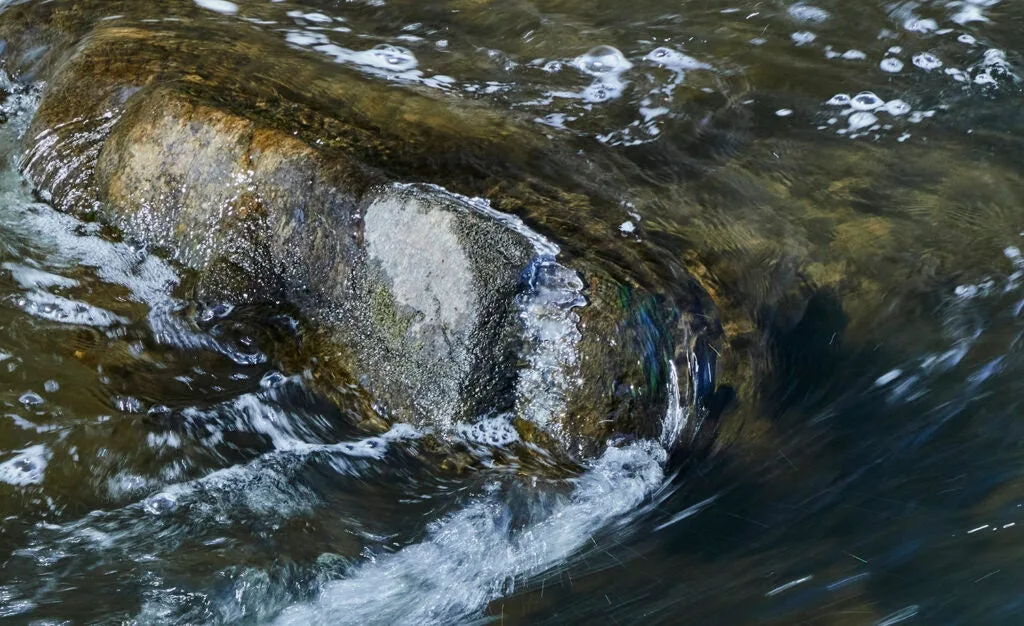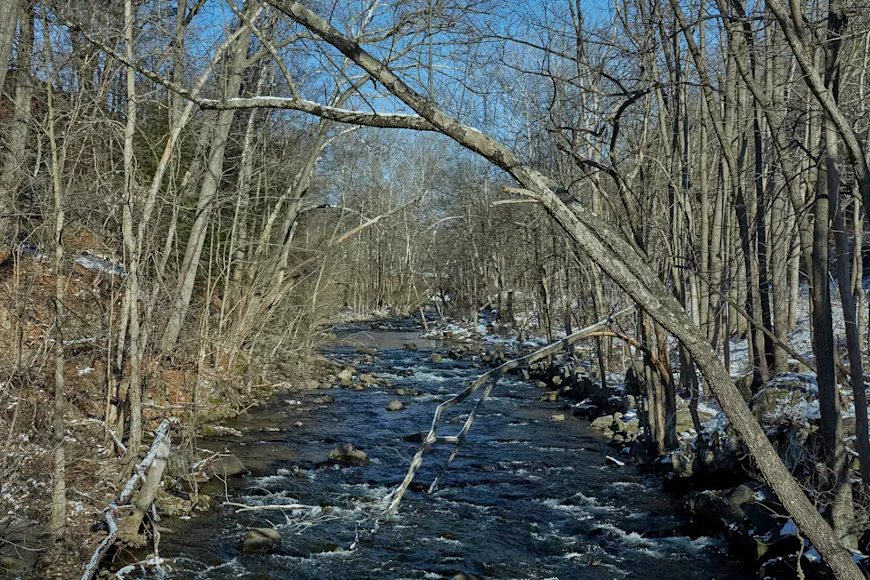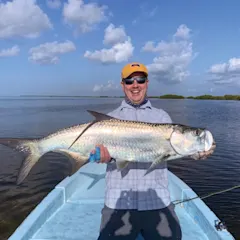SPRING
I was ready to go home. I’d been fishing for a couple of hours and had nothing to show for it. No follows. No strikes. No reason to hope for either anytime soon. It would’ve been one thing if I were on a brand-new stretch of water. But I had been coming to this river for years—mostly because it’s a quick drive from where I live—and in that time, I’d yet to have one truly memorable day of fishing here. There were trips when I might land a trout or two, but they were the exceptions. This outing seemed destined to end as another I’d soon forget.
Doubts ran through my head. What the hell am I doing here? Does this river even hold trout anymore? Or have I just forgotten how to fly fish? I considered quitting, but since I was only a few hundred yards downstream from where I’d parked, I decided to fish my way back toward the car. If by then I had still failed to catch a trout, I’d leave.
Swirling pocket water occupied most of the stream between me and the car. I had fished these spots in the past, but never with much intent. Now was my chance to try. I rigged two nymphs beneath a strike indicator and began high-sticking the softer water around the boulders. To my surprise, and delight, a rainbow trout took the Copper John fly on one of my first drifts.
Two casts later, another trout hit—but came off. Losing that fish hurt. Given my lack of success on this river, I was certain that I wouldn’t catch another. But in the next hole, my line came tight again. The trout flashed past me, granting enough of a glimpse through the clear water for me to register that this was the biggest fish I’d ever hooked on this stream. I was terrified to lose the trout, and as I kept tension on the line, I came as close to prayer as I have in ages. I desperately wanted to land that fish. I needed to land that fish. In hindsight, I suspect I was battling something larger than a trout.
It was for the best that no other anglers were around, because when that brown trout finally came into my net, I shouted, “YES!” I’ve caught bigger fish in my life, but I don’t believe I’ve ever had a bigger reaction to one. I regained my composure and released the fish back into the stream. When I was younger and more competitive, I would’ve rushed to start casting again, greedy for another trout. That day, though, I opted for a seat on a boulder in the middle of the river. At that moment, all I wanted was to enjoy the warmth of the sun coming through the trees and to listen to the water rushing over the stones and to try my best to remember everything about a fish I hope I never forget.
By then, I was near where I’d parked the car—but I wasn’t ready to go home anymore. I kept fishing.
And the fish kept biting. I picked every pocket I could find, and in almost every one, a trout took my fly. What made the day so special, though, wasn’t just the number of fish I caught. It was the deepening connection I began to feel to this river as I worked my way upstream. I noticed movements and intricacies—how certain eddies swirled, the pace and paths of drifting foam on the water surface—with more detailed awareness than I have on any other river I’ve ever fished. And during all of this, I never saw another soul. It felt as if the river had decided to reveal some of its secrets to me when no one else could listen.
Usually, at the end of a day’s fishing here, I exit the stream and walk the road to the car. It’s faster. This time, though, I stayed in the river and waded downstream, wishing to preserve the connection I felt to the water for as long as I could. At about the halfway point, I spotted a blue heron stalking in water near where I’d caught a fish hours earlier. I stopped, hoping to watch to the bird get something too, but the sight of me spooked him, and he flew downriver.

Softer water around boulders can be trout magnets. Christina Holmes
SUMMER
I returned to the river a couple more times in the spring, and the successful fishing continued—as did the strengthening connection to the water. With each trip, I felt like I learned something new about the river, such as spots that held fish and which flies they liked to eat. By the time summer arrived, I’d grown so attached to the river that I took the liberty of naming various sections: the Boulder Hole, Nightcrawler Flats, and Pickpocket Alley to name a few. Wading the river came to feel as familiar as walking around my neighborhood.
Summer’s arrival is also when I started to understand and appreciate the sense of escape the river had been providing me. Even on days when the fishing was slow, I found there was no place I’d rather be than in those waters—because it was there where I began to notice how the doubt and anger and fear that I battle nearly every day seemed to vanish.
I took up fly fishing when I was 17 years old, shortly after my parents divorced. The Missouri rivers and streams of my youth wound up granting me a similar sense of escape from home life that was invaluable. The sport would remain an essential part of my identity until my late twenties—when I let work, relationships, a lack of time, etc. serve as excuses for letting fly fishing slip away from my life almost entirely.
Now here I was, a 40-year-old who had gone fishing more times in just one spring and summer than I had in the past decade-plus of my life—and in that time I’d forgotten how powerful and restorative fly fishing can be. Looking back, I see now that my growing connection to this river was coinciding with an even deeper reconnection to fly fishing.
I tried to put these thoughts down in a letter I wrote last June to the author John N. Maclean, whose father’s classic, A River Runs Through It, is what inspired me to give fly fishing a try as a teenager. John and I had struck up a friendship earlier in the year after I interviewed him about his latest book, Home Waters—a companion memoir to A River Runs Through It. We stayed in touch via Facebook, but also through letters. In one, I described to John how I’d begun to feel as though I had discovered my own home waters and thanked him for inspiring that discovery through his stories of the Big Blackfoot River. A couple of weeks later, a new note from John arrived in the mail. I was eager to open it, but decided to save it for the right time.
The right time wound up being just days later, moments after I released a stout 15-inch brown trout—my new personal best from the river. I sat down on a boulder, took the letter from my fly-fishing vest, and began to read. The note was short, but the words were kind, the message inspiring. John encouraged me to write, someday, about my home waters.
Inside a pocket on my fly vest, I keep a small plastic bag filled with a collection of good-luck charms: letters, tokens, small items from family and friends. It’s something I assembled when I was 17 years old—the night before my first-ever fishing trip—and I have never gone to a trout stream without it. Over the decades, a select few charms have been added. The most recent, when I got home from the river that day in June, was John’s letter.

A patch of water roils beneath the dam. Christina Holmes
FALL
In late October, I traveled farther from my home waters than I ever hope to again. My wife and I took a trip to Egypt—a dream vacation that we’d booked in 2019 for 2020, but then canceled for obvious reasons. Midway through 2021, as the pandemic relented, we decided to go. Then, a couple of weeks before we were due to depart, we almost canceled the trip again—not because of COVID this time, but because Amanda was pregnant. For us, this was a first. We visited her doctor and asked his opinion. He assured us that it was safe for her to travel. “Have fun,” he said. “Come see me when you’re back.”
Five months later, I still can’t quite comprehend many of the wonders we saw on that trip. The sights that have remained most vivid for me, however, are somewhat unexpected—a river and some birds.
For six days, we sailed down the Nile, and in the mornings and just before dusk, the bird-watching was spectacular. I spotted a glossy ibis, pied kingfishers, a Eurasian hoopoe, and a gray heron among others. Mostly I watched them alone, but one evening, toward the end of the trip, Amanda came up to the top deck to admire them with me. I showed her the heron and told her that it reminded me of the blue heron I had seen back in New York, on my home waters.
I rarely want a vacation to end, but in that moment, all I could think of was stream water rushing over stones, a brown trout streaking past me, a blue heron flying downriver. I missed my river. I was ready to go home.
As instructed, right after we returned from Egypt, we visited Amanda’s OB. He’s a fairly animated guy who talks a lot—traits that, for me, made the silent blankness on his face the instant he looked at the ultrasound monitor so telling. As he exited the room, he encouraged us to take our time before leaving. Amanda and I waited for the sound of a closed door before we moved toward an embrace and said we were sorry and cried.
That was a Tuesday. A numbing grief has fogged the days that followed, but at some point in the next week I remember coming to a decision that everything else in my life could wait and that I needed to go fly fishing. When I arrived at the river I was grateful to discover there were no other fishermen. I could be alone. I walked downstream and entered the river at the Boulder Hole. A few casts in, I landed a small, red-freckled brown trout. Before I released the fish, I took a photo and texted it to Amanda. This one felt good to catch. I love you.

Surface chop in winter. Christina Holmes
WINTER
Almost as soon as I stepped into the river, a gentle snowfall began to season the water. I paused before casting and watched. One of the more remarkable things about limiting yourself to fish only the same stretch of the same river for an entire year is that you become more aware of the finer changes—the foliage on the bank, the strength of the current, the absence of certain birds—from one season to the next. I couldn’t begin to count the number of times I’ve stood in that exact spot on the river, looking upstream, and yet now, in winter, with the snow dissolving into riffles, what I observed felt brand-new. I have never seen a length of river look more peaceful or beautiful.
More than a month had passed since my last trip here, and I had begun to feel the restlessness that sets in if I let too much time expire between outings. The feeling is not so much a desire to fish—although that’s a factor—as much as it is a desire just to be here, standing in these waters that, whether it’s true or not, I’ve come to believe I know more intimately than anyone else alive. So even if it meant I had to fish during a snowstorm on a day when the forecast high was 30 degrees—conditions in which my odds of catching a trout were slim at best—I didn’t care. I was simply content to be back on these waters.
I spent the next five hours working my way upstream, hitting every spot that had given me a fish in the last year, and came up empty. No strikes. No follows. No reason to hope for either anytime soon. And I was fine with that—so much so that, eventually, I decided to quit fishing and use what daylight remained to sit down and admire the river. A scrapbook of the fish I’d caught here flipped through my thoughts—but so too did the moments when catching fish was the last thing on my mind, when catching fish was not the reason I’d come to this river.
There were times in the last year when I wanted to believe that as long as I was on this river, nothing bad could touch me—no self-doubt or rage, nothing to fear. Deep down, of course, I knew that wasn’t true; it’s just that now, I have more clarity on what is. And what’s true is that this river is here—here for me when I need a place where I can escape to think and heal, so that when I leave it, I feel better. What’s true is that this river will always be here—here for me through the changes ahead in my life, one season to the next.
As I continued to watch the snow fall on the water, I began to imagine what the river might look like in the coming spring: Banks blooming. Pockets roiling. Heron stalking. I thought, Soon. For now, though, it was only getting colder and darker. I pictured Amanda, waiting for me in our warm apartment with the lights on.
I stood and began to walk downstream. I was ready to go home.






